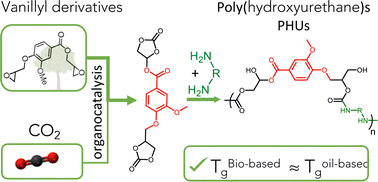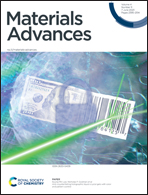Bio-based non-isocyanate poly(hydroxy urethane)s (PHU) derived from vanillin and CO2†
Abstract
As an alternative to the use of hazardous phosgene-based isocyanates for polyurethane preparation, non-isocyanate poly(hydroxy urethanes) (PHU) based on 5-membered cyclic carbonates have been developed. However, to date, most aromatic PHUs are oil-based or based on toxic precursors such as bisphenol-A. In this work, bio-based non-isocyanate poly(hydroxy urethanes) (PHUs) prepared from vanillin are reported for the first time. First, three different vanillin-derived bis-cyclic carbonates were synthesized. Subsequently, each monomer was reacted with two different bis-amines to yield six different PHUs, which were characterized in depth by 1H and 13C NMR spectroscopy, FTIR, SEC and DSC. PHUs based on vanillic acid were found to exhibit thermal properties superior to bisphenol A-based PHUs, with a Tg of around 66 °C. It is envisioned that vanillin-based PHUs could potentially be a safer alternative to harmful bisphenol A-based PHUs and provide a useful strategy for CO2 revalorization, especially considering that vanillin is an abundant byproduct of Kraft lignin production.

- This article is part of the themed collection: Early Stage Investigator Honorees of the ACS Polymeric Materials Science & Engineering Division


 Please wait while we load your content...
Please wait while we load your content...